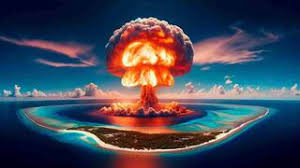
china has taken such a step in the field of weapon technology that has shocked the world. China's State Shipbuilding Corporation (CSSC) has successfully tested a completely new hydrogen-based explosive technology. The special thing is that it is not based on nuclear fusion like a traditional hydrogen bomb but on a special chemical process in which magnesium Hydride is used.
Very light, but very powerful
This new device weighs only 2 kilograms but its capabilities are astonishing. When it is triggered with a normal explosive, magnesium hydride heats up rapidly and releases hydrogen gas. This gas flares up as soon as it comes in contact with air and creates a wall of fire with a temperature of more than 1000 ° C which is many times hotter than TNT. According to CSSC scientist Wang Xuefeng, "Hydrogen gas burns at a very low energy, its explosion area is large and its flames spread very fast." This means that this device can also rip apart materials such as aluminum alloy. In military operations, it can be very effective in destroying enemy targets with precision.
Test results
In the test conducted on the spot, this device was able to generate an overpressure of up to 428.43 kilopascals at a distance of 2 meters, which has about 40% effect compared to TNT explosive. But its real strength lies in its continuous burning heat, which is completely different from a shock wave of a normal bomb.
This device burns at extreme temperatures for two seconds, which can cause more damage in a large area. It can be used to destroy the enemy's power grid, communication center and road network with precision, thereby weakening the enemy's strategy.
magnesium hydride
Earlier this substance was produced in very limited quantities because it is very reactive. But now china has started a new plant in Shanxi province which can produce 150 tons of magnesium hydride every year. This has been made possible by the new "one-pot synthesis" technology of the Dalian Institute of Chemical Physics which makes it cheaper and safer.




 click and follow Indiaherald WhatsApp channel
click and follow Indiaherald WhatsApp channel